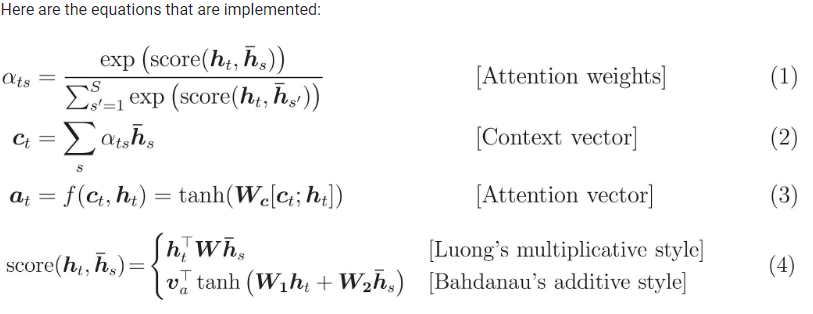tensorflow 笔记13:了解机器翻译,google NMT,Attention
一、关于Attention,关于NMT
未完待续、、、
以google 的 nmt 代码引入 探讨下端到端:
项目地址:https://github.com/tensorflow/nmt
机器翻译算是深度学习在垂直领域应用最成功的之一了,深度学习在垂直领域的应用的确能解决很多之前繁琐的问题,但是缺乏范化能力不足,这也是各大公司一直解决的问题;
最近开源的模型:
lingvo:一种新的侧重于sequence2sequence的框架;
bert :一种基于深度双向Transform的语言模型预训练策略;
端到端的解决方案,依然是目前很多NLP任务中常用的模型框架;
二、tensorflow 中的attention:
tensorflow 中主要有两种Attention:
1、Bahdanau 的 Attention
2、Luong 的 Attention
两种的计算如下所示:
分别来自两篇NMT的论文也是nmt 最经典的两篇论文:(深扒的话还是看论文吧)
1、Bahdanau 的 Attention
NEURAL MACHINE TRANSLATION BY JOINTLY LEARNING TO ALIGN AND TRANSLATE
https://arxiv.org/pdf/1409.0473.pdf
2、Luong 的 Attention
Effective Approaches to Attention-based Neural Machine Translation
https://arxiv.org/pdf/1508.04025.pdf
以下是两篇论文中如何使用Attention:

图:两个attention
两者的区别:
主要区别在于如何评估当前解码器输入和编码器输出之间的相似性。
tensorflow代码中封装好的,共有四个attention函数:
1、加入了得分偏置 bias 的 Bahdanau 的 attention
class BahdanauMonotonicAttention()
2、无得分偏置的Bahdanau 的 attention
class BahdanauAttention()
3、加入了得分偏置 bias 的Luong 的 attention
class LuongMonotonicAttention()
4、无得分偏置的Luong 的 attention
class LuongAttention()
贴一个直接封装好的代码encode 和 decoder 的代码:详细代码稍后续上
主要用到有以下几个函数:attention + beamsearch
tf.contrib.seq2seq.tile_batch
tf.contrib.seq2seq.LuongAttention
tf.contrib.seq2seq.BahdanauAttention
tf.contrib.seq2seq.AttentionWrapper
tf.contrib.seq2seq.TrainingHelper
代码片段:
def decoder(mode,encoder_outputs,encoder_state,X_len,word2id_tar,embeddings_Y,embedded_Y):
k_initializer = tf.contrib.layers.xavier_initializer()
with tf.variable_scope('decoder'):
net_mode = hp.dec_mode
beam_width = hp.beam_size
batch_size = hp.batch_size
memory = encoder_outputs
num_layers = hp.dec_num_layers if mode == 'infer':
memory = tf.contrib.seq2seq.tile_batch(memory, beam_width)
X_len = tf.contrib.seq2seq.tile_batch(X_len, beam_width)
encoder_state = tf.contrib.seq2seq.tile_batch(encoder_state, beam_width)
bs = batch_size * beam_width
else:
bs = batch_size attention = tf.contrib.seq2seq.LuongAttention(hp.dec_hidden_size, memory, X_len, scale=True) # multiplicative
# attention = tf.contrib.seq2seq.BahdanauAttention(hidden_size, memory, X_len, normalize=True) # additive
cell = multi_cells(num_layers * 2,mode,net_mode)
cell = tf.contrib.seq2seq.AttentionWrapper(cell, attention, hp.dec_hidden_size, name='attention')
decoder_initial_state = cell.zero_state(bs, tf.float32).clone(cell_state=encoder_state) with tf.variable_scope('projected'):
output_layer = tf.layers.Dense(len(word2id_tar), use_bias=False, kernel_initializer=k_initializer) if mode == 'infer':
start = tf.fill([batch_size], word2id_tar['<s>'])
decoder = tf.contrib.seq2seq.BeamSearchDecoder(cell, embeddings_Y, start, word2id_tar['</s>'],
decoder_initial_state, beam_width, output_layer)
outputs, final_context_state, _ = tf.contrib.seq2seq.dynamic_decode(decoder,
output_time_major=True,
maximum_iterations=1 * tf.reduce_max(X_len))
sample_id = outputs.predicted_ids
print ("sample_id shape")
print (sample_id.get_shape())
return "",sample_id
else:
helper = tf.contrib.seq2seq.TrainingHelper(embedded_Y, [hp.maxlen - 1 for b in range(batch_size)])
decoder = tf.contrib.seq2seq.BasicDecoder(cell, helper, decoder_initial_state, output_layer) outputs, final_context_state, _ = tf.contrib.seq2seq.dynamic_decode(decoder,
output_time_major=True)
logits = outputs.rnn_output
logits = tf.transpose(logits, (1, 0, 2))
print(logits)
return logits,""
贴一下 google nmt 的代码:google 里面写的也很详细了
主要三部分: attention,encoder,decoder,计算方式如上图,流程如以下代码所描述;
#两个 attention代码:依据的是: 上图:两个attention class LuongAttentionAttention(tf.keras.Model):
def __init__(self, units):
super(LuongAttention, self).__init__()
self.W = tf.keras.layers.Dense(units) def call(self, query, values):
# hidden shape == (batch_size, hidden size)
# hidden_with_time_axis shape == (batch_size, 1, hidden size)
# we are doing this to perform addition to calculate the score
hidden_with_time_axis = tf.expand_dims(query, 1) # score shape == (batch_size, max_length, hidden_size)
#矩阵转置 转置前:[batch_size,max_length,hidden_size] 转置后:[batch_size,hidden_size,max_length]
score = tf.transpose(values, perm=[0, 2, 1])*self.W(hidden_with_time_axis))) # attention_weights shape == (batch_size, max_length, 1)
# we get 1 at the last axis because we are applying score to self.V
attention_weights = tf.nn.softmax(score, axis=1) # context_vector shape after sum == (batch_size, hidden_size)
context_vector = attention_weights * values
context_vector = tf.reduce_sum(context_vector, axis=1) return context_vector, attention_weights #BahdanauAttention:#计算 attention class BahdanauAttention(tf.keras.Model):
def __init__(self, units):
super(BahdanauAttention, self).__init__()
self.W1 = tf.keras.layers.Dense(units)
self.W2 = tf.keras.layers.Dense(units)
self.V = tf.keras.layers.Dense(1) def call(self, query, values):
# hidden shape == (batch_size, hidden size)
# hidden_with_time_axis shape == (batch_size, 1, hidden size)
# we are doing this to perform addition to calculate the score
hidden_with_time_axis = tf.expand_dims(query, 1) # score shape == (batch_size, max_length, hidden_size)
score = self.V(tf.nn.tanh(
self.W1(values) + self.W2(hidden_with_time_axis))) # attention_weights shape == (batch_size, max_length, 1)
# we get 1 at the last axis because we are applying score to self.V
attention_weights = tf.nn.softmax(score, axis=1) # context_vector shape after sum == (batch_size, hidden_size)
context_vector = attention_weights * values
context_vector = tf.reduce_sum(context_vector, axis=1) return context_vector, attention_weights decoder 的部分代码
class Decoder(tf.keras.Model):
def __init__(self, vocab_size, embedding_dim, dec_units, batch_sz):
super(Decoder, self).__init__()
self.batch_sz = batch_sz
self.dec_units = dec_units
self.embedding = tf.keras.layers.Embedding(vocab_size, embedding_dim) # 参数简说:
self.gru = tf.keras.layers.GRU(self.dec_units,
return_sequences=True,
return_state=True,
recurrent_initializer='glorot_uniform')
self.fc = tf.keras.layers.Dense(vocab_size) # used for attention
self.attention = BahdanauAttention(self.dec_units) def call(self, x, hidden, enc_output):
# enc_output shape == (batch_size, max_length, hidden_size)
#调用 attention 函数,传入,上个时刻的 hidden 和 encoder 的 outputs
# context_vector 加权平均后的 Ci(论文中的),attention_weights 权重值
context_vector, attention_weights = self.attention(hidden, enc_output) # x shape after passing through embedding == (batch_size, 1, embedding_dim)
x = self.embedding(x) # x shape after concatenation == (batch_size, 1, embedding_dim + hidden_size) # context_vector 和 embedding 后的 X 进行结合
x = tf.concat([tf.expand_dims(context_vector, 1), x], axis=-1) # passing the concatenated vector to the GRU
# 此时的 output 应该 等于 state;
output, state = self.gru(x) # output shape == (batch_size * 1, hidden_size)
output = tf.reshape(output, (-1, output.shape[2])) # output shape == (batch_size, vocab)
x = self.fc(output) # 输出 outputs 全连接之后的 x,隐藏层的state,attention 的score,x在训练的时候直接作为损失; return x, state, attention_weights #训练的部分代码:
def train_step(inp, targ, enc_hidden):
loss = 0 with tf.GradientTape() as tape:
# encoder 部分的代码,直接取的所有的输出和最后的隐藏层;
enc_output, enc_hidden = encoder(inp, enc_hidden) dec_hidden = enc_hidden dec_input = tf.expand_dims([targ_lang.word_index['<start>']] * BATCH_SIZE, 1) # Teacher forcing - feeding the target as the next input
#按照句子的长度一个一个的进行输入;
for t in range(1, targ.shape[1]):
# passing enc_output to the decoder
# 获得decoder 每一时刻的输出 和隐藏层的输出;
predictions, dec_hidden, _ = decoder(dec_input, dec_hidden, enc_output) loss += loss_function(targ[:, t], predictions) # using teacher forcing
dec_input = tf.expand_dims(targ[:, t], 1) batch_loss = (loss / int(targ.shape[1])) variables = encoder.trainable_variables + decoder.trainable_variables gradients = tape.gradient(loss, variables) optimizer.apply_gradients(zip(gradients, variables)) return batch_loss
tensorflow 笔记13:了解机器翻译,google NMT,Attention的更多相关文章
- 神经机器翻译(NMT)相关资料整理
作者:zhbzz2007 出处:http://www.cnblogs.com/zhbzz2007 欢迎转载,也请保留这段声明.谢谢! 1 简介 自2013年提出了神经机器翻译系统之后,神经机器翻译系统 ...
- google nmt 实验踩坑记录
最近因为要做一个title压缩的任务,所以调研了一些text summary的方法. text summary 一般分为抽取式和生成式两种.前者一般是从原始的文本中抽取出重要的word o ...
- tensorflow笔记(三)之 tensorboard的使用
tensorflow笔记(三)之 tensorboard的使用 版权声明:本文为博主原创文章,转载请指明转载地址 http://www.cnblogs.com/fydeblog/p/7429344.h ...
- tensorflow笔记:多层LSTM代码分析
tensorflow笔记:多层LSTM代码分析 标签(空格分隔): tensorflow笔记 tensorflow笔记系列: (一) tensorflow笔记:流程,概念和简单代码注释 (二) ten ...
- tensorflow笔记:使用tf来实现word2vec
(一) tensorflow笔记:流程,概念和简单代码注释 (二) tensorflow笔记:多层CNN代码分析 (三) tensorflow笔记:多层LSTM代码分析 (四) tensorflow笔 ...
- tensorflow笔记:流程,概念和简单代码注释
tensorflow是google在2015年开源的深度学习框架,可以很方便的检验算法效果.这两天看了看官方的tutorial,极客学院的文档,以及综合tensorflow的源码,把自己的心得整理了一 ...
- 20180929 北京大学 人工智能实践:Tensorflow笔记01
北京大学 人工智能实践:Tensorflow笔记 https://www.bilibili.com/video/av22530538/?p=13 (完)
- 机器学习实战 - 读书笔记(13) - 利用PCA来简化数据
前言 最近在看Peter Harrington写的"机器学习实战",这是我的学习心得,这次是第13章 - 利用PCA来简化数据. 这里介绍,机器学习中的降维技术,可简化样品数据. ...
- Ext.Net学习笔记13:Ext.Net GridPanel Sorter用法
Ext.Net学习笔记13:Ext.Net GridPanel Sorter用法 这篇笔记将介绍如何使用Ext.Net GridPanel 中使用Sorter. 默认情况下,Ext.Net GridP ...
随机推荐
- Asp.Net判断文件是否存在
在上传文件时经常要判断文件夹是否存在,如果存在就上传文件,否则新建文件夹再上传文件 判断语句为 if (System.IO.Directory.Exists(Server.MapPath(" ...
- Yahoo Programming Contest 2019.E.Odd Subrectangles(思路 线性基)
题目链接 \(Description\) 给定一个\(n\times m\)的\(01\)矩阵.求任意选出\(r\)行.\(c\)列(共\(2^{n+m}\)种方案),使得这\(r\)行\(c\)列的 ...
- K1 K2作为中断源控制红色LED灯,实现任意键按一下LED灯亮或者灭
#include "stm32f10x.h" // 相当于51单片机中的 #include <reg51.h> #include "stm32f10x_gpi ...
- [HNOI2010]平面图判定
Description: 若能将无向图 \(G=(V, E)\) 画在平面上使得任意两条无重合顶点的边不相交,则称 \(G\) 是平面图.判定一个图是否为平面图的问题是图论中的一个重要问题.现在假设你 ...
- C语言基础三(敲打键盘、寻找资料,循环语句)
有人在学C语言或者其他语言的时候,大家都会说逻辑思维的硬道理,认为没有逻辑思维的人走不远,那么小编这里借助简单的if...else... 英文解释if(如果),else(否则) ----------- ...
- 全局解释器锁 GIL
1.什么是GIL? GIL本质上是互斥锁,可以将并发运行变为串行,以此来控制同一时间内共享数据只能被一个任务修改,保证时间安全 2.GIL应用场景 使用原因:Cpython解释器自带垃圾回收机制不是线 ...
- 2017.07.10【NOIP提高组】模拟赛B组
Summary 今天题目总体不是难,但是分数很低,只有100+10+30,其中第二题还是以前做过的,第一题设计数论,而且以前做过同一个类型的题目,比赛推了很长时间.第三题时以前做过的原题,是贪心没学好 ...
- java.lang.NoSuchMethodException: .<init>()
严重: Servlet.service() for servlet [springmvc] in context with path [/SpringMvc-1] threw exception [R ...
- Egret 类的创建和继承--TypeScript
class test extends egret.DisplayObjectContainer { /** * 类的创建 */ //属性 name: string; age: number; ts: ...
- 3ds max学习笔记(三)--视点显示控制
显示模式:1.模型一般是以实体方式显示的,若想看线框方式,摁F3:返回实体,摁F3:2.实体加线框模式显示,摁F4:返回,摁F4:3.透明效果:ALT+X,透明显示,之后F4,显示线框:程序内的其他显 ...
